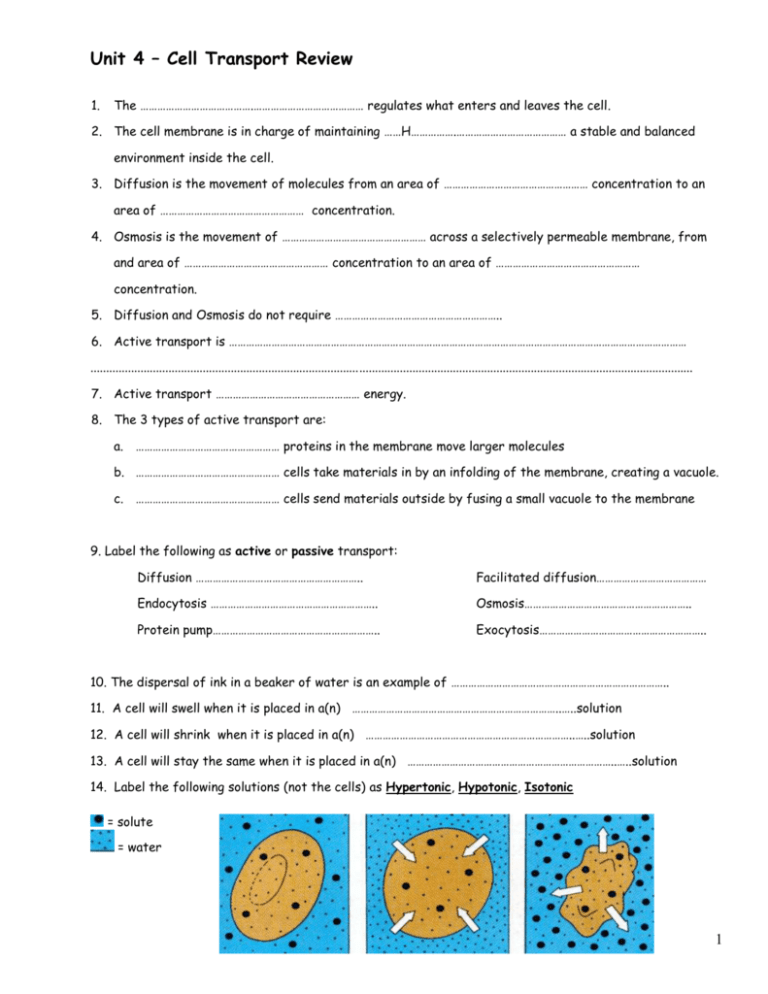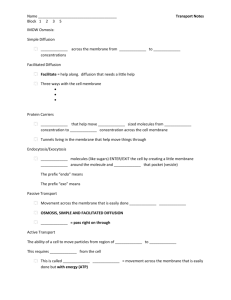Unit 5 – Cells – Review/Study Guide
advertisement

Unit 4 – Cell Transport Review 1. The ………………………………….………………………………… regulates what enters and leaves the cell. 2. The cell membrane is in charge of maintaining ……H…………….………………………………… a stable and balanced environment inside the cell. 3. Diffusion is the movement of molecules from an area of …………………………………………… concentration to an area of …………………………………………… concentration. 4. Osmosis is the movement of …………………………………………… across a selectively permeable membrane, from and area of …………………………………………… concentration to an area of …………………………………………… concentration. 5. Diffusion and Osmosis do not require ………………………………………………….. 6. Active transport is ……………………………………………………………………………………………………………………………………………… ................................................................................................................................................................................................. 7. Active transport …………………………………………… energy. 8. The 3 types of active transport are: a. …………………………………………… proteins in the membrane move larger molecules b. …………………………………………… cells take materials in by an infolding of the membrane, creating a vacuole. c. …………………………………………… cells send materials outside by fusing a small vacuole to the membrane 9. Label the following as active or passive transport: Diffusion ………………………………………………….. Facilitated diffusion………………………………… Endocytosis ………………………………………………….. Osmosis………………………………………………….. Protein pump………………………………………………….. Exocytosis………………………………………………….. 10. The dispersal of ink in a beaker of water is an example of ………………………………………………………………….. 11. A cell will swell when it is placed in a(n) ………………………………………………………………..…..solution 12. A cell will shrink when it is placed in a(n) ………………………………………………………………..…..solution 13. A cell will stay the same when it is placed in a(n) ………………………………………………………………..…..solution 14. Label the following solutions (not the cells) as Hypertonic, Hypotonic, Isotonic = solute = water 1 15. Label: phospholipids, proteins, cholesterol, lipid bilayer, 16. Active transport requires an input of ……………………………………… in the form of ………………….. Active Transport: Protein pumps Active transport is the movement of molecules from LOW to HIGH concentration using ATP ENERGY and PROTEIN gates (channels). The particles go against the concentration gradient (against the flow). 9. Explain, in scientific terms, what is happening to the Hydrogen ions (H+) in this diagram. …………………………………………………………………………………… …………………………………………………………………………………… …………………………………………………………………………………… …………………………………………………………………………………… …………………………………………………………………………………… Protein Pump …………………………………………………………………………………… Active transport: Exocytosis and Endocytosis Movement of materials using vesicles (pockets of cell membrane). Requires energy (ATP). 10. Label: endocytosis and exocytosis in the diagram below. Explain what is happening in both sides of this diagram. Please use scientific words when possible. …………………………………………………………………………………… Cell …………………………………………………………………………………… …………………………………………………………………………………… …………………………………………………………………………………… …………………………………………………………………………………… …………………………………………………………………………………… 2 Identify the diagrams below as showing DIFFUSION, OSMOSIS, PROTEIN PUMPS, EXOCYTOSIS, ENDOCYTOSIS. _________________________ _________________________ _______________________ _______________________ _______________________ ____________________ O2 _______________________ ____________________ 3 _______________________ ____________________ 1. The cell membrane contains channels and pumps that help move materials from one side to the other. What are these channels and pumps made of? a. carbohydrates c. bilipids b. lipids d. proteins 2. Diffusion occurs because a. molecules constantly move and collide with each other. b. the concentration of a solution is never the same throughout a solution. c. the concentration of a solution is always the same throughout a solution. d. molecules never move or collide with each other. 3. When the concentration of molecules on both sides of a membrane is the same, the molecules will a. move across the membrane to the outside of the cell. b. stop moving across the membrane. c. move across the membrane in both directions. d. move across the membrane to the inside of the cell. 4. Which type of particle transport requires input of energy from the cell? …………………………….……….. 5. All of the following are examples of cell specialization EXCEPT a. a pancreatic cell that produces protein-digesting enzymes. b. muscle cells that control movement of materials in the body c. a prokaryotic cell that carries out photosynthesis. d. a red blood cell that carries oxygen. 6. Molecules that are too large to be moved through the membrane can be transported into or removed from the cell by………………………………………………………………………………………………………. 7. A cell moves particles from a region of lesser concentration to a region of greater concentration by a. osmosis b. diffusion c. active transport pump 8. The structure most responsible for maintaining cell homeostasis is the _____. a. cytoplasm c. cell wall b. mitochondrion d. plasma membrane 9. Which processes are shown in these two figures? Label them. 4







